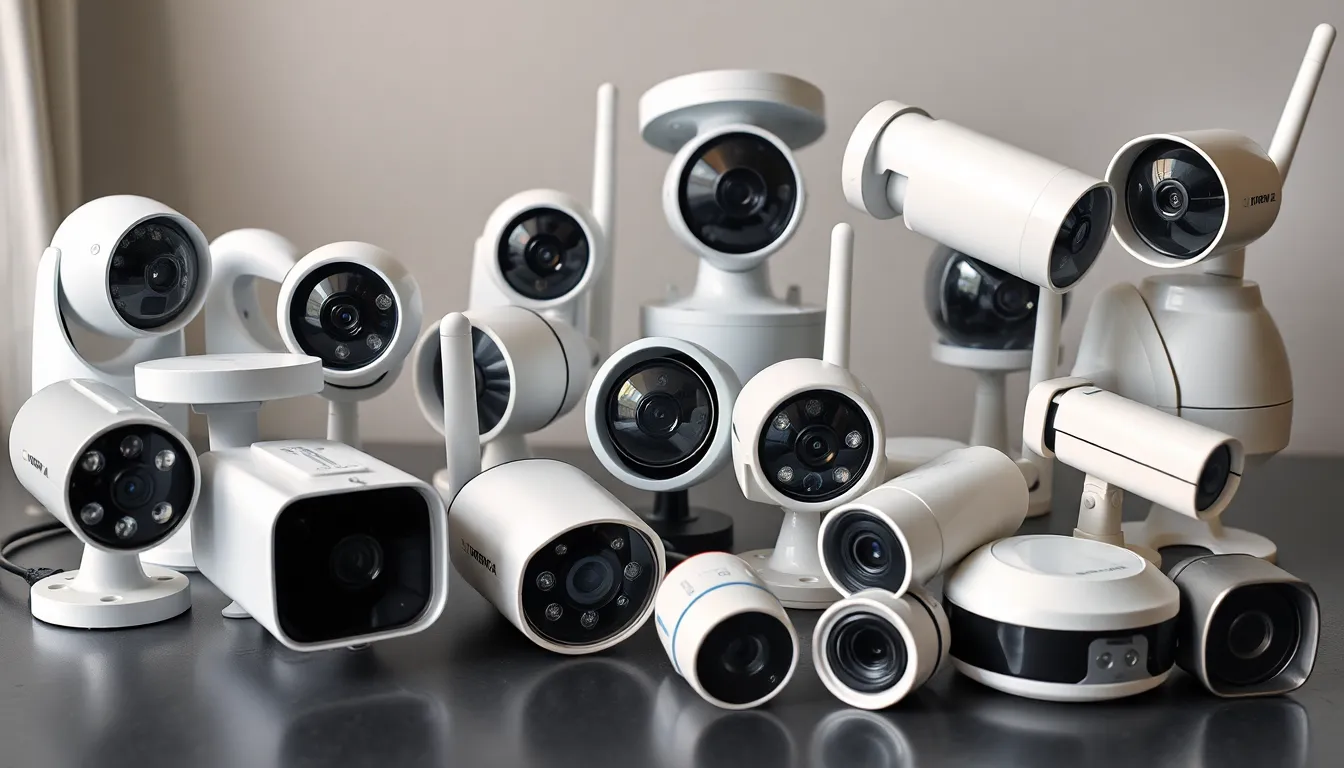In a world where privacy feels as elusive as a cat in a room full of rocking chairs, security cameras have become the watchful eyes of our homes and businesses. They’re like the nosy neighbor who always knows what’s happening, but with a little less gossip. However, with great power comes great responsibility—especially when it comes to knowing the rules of the camera game.
Table of Contents
ToggleUnderstanding Security Camera Rules
Security cameras play a vital role in enhancing safety, yet awareness of security camera rules remains crucial for users. These rules establish the boundaries for monitoring spaces without violating privacy and legal guidelines.
Privacy Considerations
Monitoring individuals in private areas presents privacy concerns. Surveillance cameras shouldn’t capture activities in places where people expect privacy, such as bathrooms or bedrooms. Consent becomes essential when recording in shared spaces. Informing guests of surveillance fosters transparency and builds trust. Local and state laws may dictate further requirements regarding consent. Always check regulations to ensure compliance while respecting individuals’ rights.
Legal Regulations
Legal regulations govern the use of security cameras. Various laws dictate where and how cameras can be installed. Federal laws generally permit monitoring in public areas without consent. Specific jurisdictions may have stricter laws requiring notice or consent in certain situations. Understanding these regulations prevents potential legal issues. Consultation with legal experts provides clarity on installations and best practices within specific locations. Adhering to the law safeguards both privacy interests and the user’s rights.
Types of Security Cameras

Understanding the different types of security cameras helps users choose the right surveillance solution for their needs. Cameras vary by purpose and features, addressing specific security requirements.
Indoor vs. Outdoor Cameras
Indoor cameras focus on monitoring activities within a home or building. They often feature infrared capabilities for low-light scenarios, ensuring effective surveillance even at night. Outdoor cameras are built to withstand diverse weather conditions. Typically, they’re equipped with weather-resistant casings and enhanced durability, allowing them to capture clear footage in rain or snow. Users should consider installation height and angles for optimal coverage when selecting indoor or outdoor models.
Wired vs. Wireless Cameras
Wired cameras rely on physical cables for data transmission and power supply. These models often provide stable video quality, reducing latency issues. Wireless cameras use Wi-Fi for connectivity, simplifying installation since they don’t require elaborate wiring. Flexibility in placement remains a key advantage of wireless options, allowing users to relocate cameras easily. While wired systems often offer a more consistent feed, wireless cameras bring convenience and versatility for various surveillance scenarios.
Installing Security Cameras
Installing security cameras requires careful consideration of placement and setup to ensure effective monitoring while respecting privacy.
Placement Guidelines
Select strategic locations for cameras to maximize surveillance coverage. Position cameras at entry points, such as doors and windows, and in high-traffic areas. Avoid installing cameras in places where individuals expect privacy, including bathrooms or bedrooms. Ensure cameras capture critical angles, reducing blind spots. Use a height that discourages tampering while providing a clear view of faces. Consider environmental factors, such as lighting, to optimize video quality. Assess potential obstructions that may block the camera’s view.
Best Practices for Setup
Incorporate consistent power sources for wired cameras to maintain reliable performance. Wireless cameras require a strong Wi-Fi connection for uninterrupted video streaming. Use encryption and strong passwords to protect video feeds from unauthorized access. Regularly test cameras after installation to confirm they function correctly. Maintain proper cable management for wired systems to reduce hazards and enhance aesthetics. Check the camera’s field of vision through preliminary tests, adjusting angles as needed. Schedule routine maintenance checks to ensure ongoing effectiveness and address any technical issues promptly.
Compliance with Security Camera Rules
Understanding security camera regulations is vital for users. Keeping compliance in mind helps prevent legal complications.
Notification Requirements
Many jurisdictions mandate that individuals be notified of surveillance activities. Users often need to place signs indicating the presence of security cameras in visible locations. Transparency fosters trust, and informing employees or visitors about monitoring can enhance comfort. In homes, it’s essential to communicate with family members about camera installation to ensure collective agreement on privacy matters. Failure to notify can lead to legal challenges, especially in areas where privacy expectations are high.
Data Storage and Access
Proper data management is crucial for compliance with security camera rules. Recording footage from security cameras must align with local legislation regarding data retention. Users typically must secure the recorded data, limiting access to authorized individuals only. Implementing password protection for storage devices or cloud services minimizes unauthorized access risks. Establishing a clear policy on data retention duration, often recommended to be no longer than necessary for security purposes, provides clarity and maintains accountability.
Consequences of Violating Security Camera Rules
Violating security camera rules can lead to serious consequences. Understanding the potential outcomes emphasizes the need for compliance.
Legal Repercussions
Legal issues often arise when security camera rules are disregarded. Violaters may face hefty fines ranging from $1,000 to $10,000, depending on jurisdiction. Laws differ across states, with some regions enforcing stricter regulations than others. Recording individuals in private areas without consent can expose users to lawsuits. Lawsuits could result in financial loss and reputational damage. Additionally, criminal charges may be applicable for severe breaches, leading to possible imprisonment. Compliance with local laws ensures protection against these potential legal pitfalls.
Ethical Implications
Ethical considerations are critical when employing security cameras. Breaching privacy expectations can undermine trust among employees and visitors. Surveillance in areas where individuals expect privacy, like restrooms or changing rooms, raises moral concerns. An invasion of privacy can lead to a toxic environment and deteriorate relationships. Transparency aids in fostering a culture of respect. Informing individuals about surveillance builds a sense of trustworthiness. Adhering to ethical standards not only safeguards individuals but also enhances organizational integrity.
Navigating the landscape of security camera usage requires a careful balance between enhancing safety and respecting privacy. By understanding the rules and regulations, individuals can effectively protect their spaces while fostering trust among those being monitored.
Being transparent about surveillance practices not only complies with legal requirements but also promotes a culture of respect. Regular maintenance and proper data management further ensure that security systems operate effectively and ethically.
Ultimately, adhering to security camera rules empowers users to create a secure environment that values the rights and privacy of everyone involved.





